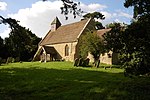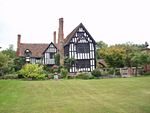St John the Baptist is a church in White Ladies Aston, Worcestershire, England. It has been designated as a Grade II* listed building by Historic England.It is a building of Norman origin, dating from 1204 when Robert de Everay made a gift of two palfreys to the Bishop of Worcester. This action won Robert the right to present a candidate for the office of vicar to the parish of Aston Episcopi and it was understood he intended to build a stone church. Today the stone church stands with a wooden spire. The doorway is Norman and the font is probably of the 13th century.
In 1255 Aston was renamed White Ladies Aston as linked to Whistones Priory and Cistercian Nuns. Details of the endowment to the nuns included 51 acres of arable land and 2 acres of meadow at Aston Episcopi, or White Ladies' Aston, together with the tithes of the demesne lands at Northwick and Newland (Worcester), and lands in Claines. A further grant was made by Bishop Giffard in 1283 of the tithes of the chapel of Aston Episcopi, or White Ladies' Aston. The church's links with the White Ladies ended in 1536 when Whistones Priory was closed in the Dissolution of the Monasteries an action authorised by King Henry VIII during the Reformation of the Church in England from Roman Catholic to Protestant.
The oldest timbers in the tower and spire date back to the 15th Century and in 1410 a new bell was purchased for the church.
The 17th century, during the time of the English Civil War, there was the growth of extreme religious groups which caused problems in the country, even in the Church of John the Baptist. In 1652 the curate, John Moseley was ejected from the church over anti Quaker sermons; in 1656 Robert Brown, a Fifth Monarchy Man caused trouble in the congregation and in 1661 this curate was ejected from the church over pro Commonwealth sermons at the time of the Restoration of King Charles II.
The Reverend Henry Martyn Sherwood (son of Mary Martha Sherwood 19th-century English children's writer and Captain Henry Sherwood of the 53rd (Shropshire) Regiment of Foot) served the Church of White Ladies Aston from 1839 - 1910, the second longest serving vicar in the Church of England. He was active in creating changes in the village, extending the church, providing education, improving roads and providing the Parish Room.
In 1848 the church was described by John Noake, as being in a poor condition with "broken glass", "the chancel is divided from the nave by a thick wall … with a large square opening" and as Nash observed, the high pews were so high that "when I sat down …. the congregation and the World entire, were totally shut out."
In 1861 extensive building work completed. A complete new North Aisle and Vestry were built, the Early English stonework and timbers were completely overhauled. New pews were installed and the seating accommodation increased from 73 to 155. An avenue of 22 Yew Trees, one for each year the Rev. Sherwood was Vicar, were planted on each side of the approach path. The costs of the work were met by private subscription and a £50 grant was given by the Incorporated Society for Building of Churches. A large donation, which covered much of the cost of the repair was made by Mr. Perrins of Worcester to honour a longstanding Family Debt of Gratitude. Mr. Perrin's grandfather who owned a chemist's shop, made up an Indian Sauce to a recipe left by Lord Sandys of Ombersley's housekeeper in 1812. Capt. Sherwood, on leave from India, purchased a bottle and suggested to Mr. Perrins that he should produce it commercially. This he later did, in company with Mr. Lea, and the firm prospered so well that Mr. Perrin's father promised a reward to Capt. Sherwood's son, the Rev. Sherwood. An annual renewal of the offer became a tradition between the Perrins and Sherwood families but it had been repeatedly declined until the present occasion.
In 1864 a new porch was added, in 1938 East Window installed and in 1985 repairs were completed on the wooden spire.









